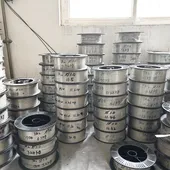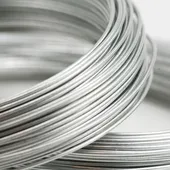
From Sponge to Spool: The Manufacturing Journey of Titanium Wire
Titanium wire is renowned for its remarkable performance, but its journey from raw material to a precision-spooled product is a complex feat of engineering. Unlike common metals, titanium demands a highly controlled process to preserve its purity and achieve its famous properties. Understanding this journey reveals why quality control at every step is paramount.
Step 1: Melting the Ingot in a Vacuum
The process begins not with ore, but with a porous material called “titanium sponge.” This sponge is blended with any required alloying elements (like aluminum and vanadium for Grade 5) and compacted.
Because molten titanium reacts aggressively with oxygen and nitrogen in the air, melting must occur in a vacuum. The most common method is Vacuum Arc Remelting (VAR). An electric arc melts the compacted material in a water-cooled copper crucible, causing it to solidify into a dense, solid cylinder called an ingot. This vacuum process is critical—it prevents the absorption of impurities that would make the final wire brittle and weak.
Step 2: Primary Breakdown – Forging and Rolling
The solidified ingot, which can weigh several tons, is too large for wire production. It must be broken down. The ingot is heated and then forged or hot-rolled into a much smaller, more manageable form called a “billet” or “rod.” This hot-working process not only reduces the diameter but also refines the internal grain structure of the metal, improving its strength and homogeneity.
Step 3: The Drawing Process – Creating the Wire
This is where the rod truly becomes a wire. Wire drawing is a cold-working process where the titanium rod is pulled through a series of dies, each slightly smaller than the last. A specialized lubricant is used to reduce friction and heat.
With each pass through a die, the wire gets longer and thinner. This process also “work-hardens” the titanium, significantly increasing its tensile strength but reducing its ductility (flexibility).
Step 4: Annealing – Restoring Ductility
After several drawing passes, the wire becomes too hard and brittle to be drawn further without breaking. To solve this, the wire undergoes an annealing process. It is heated to a specific temperature in a controlled atmosphere (or vacuum) and then slowly cooled.
This heat treatment relieves the internal stresses, softens the metal, and restores its ductility, making it ready for further drawing. The cycle of drawing and annealing is repeated until the wire reaches its final, precise diameter. The final anneal determines the wire’s end-temper, whether it needs to be soft and formable or left in a harder state for spring applications.
Step 5: Finishing and Quality Control
The final step involves cleaning the wire to remove any residual lubricants or surface oxides, resulting in a bright, clean finish. It is then carefully wound onto spools.
Throughout this entire journey, rigorous quality control is essential. Checks are performed to verify:
- Chemical Composition: Ensuring the grade is correct.
- Dimensional Tolerance: Measuring the diameter to ensure it’s within specification.
- Mechanical Properties: Testing for tensile strength, elongation, and other required characteristics.
The path from sponge to spool is a testament to precision manufacturing. It is this meticulous, multi-stage process that guarantees every meter of titanium wire delivers the exceptional performance and reliability that critical industries depend on.
Quick Contact
Related Products
-

Titanium Wires
Titanium Wires
Product Categories
- Titanium Anode Basket 1
- Titanium Foils 1
- Titanium Pipes 1
- Titanium Rods 1
- Titanium Tubes 1
- Titanium Wires 3
- Nuts & Bolts 1
- Special Titanium Alloys 1
- Titanium Anodes & Electrodes 1
- Titanium Equipment 1
- Titanium Mesh 1
- Titanium Sheets & Plates 1
- Titanium rods 3
- Titanium foils 3
- Titanium sheets and plates 3
- Titanium pipes 3
